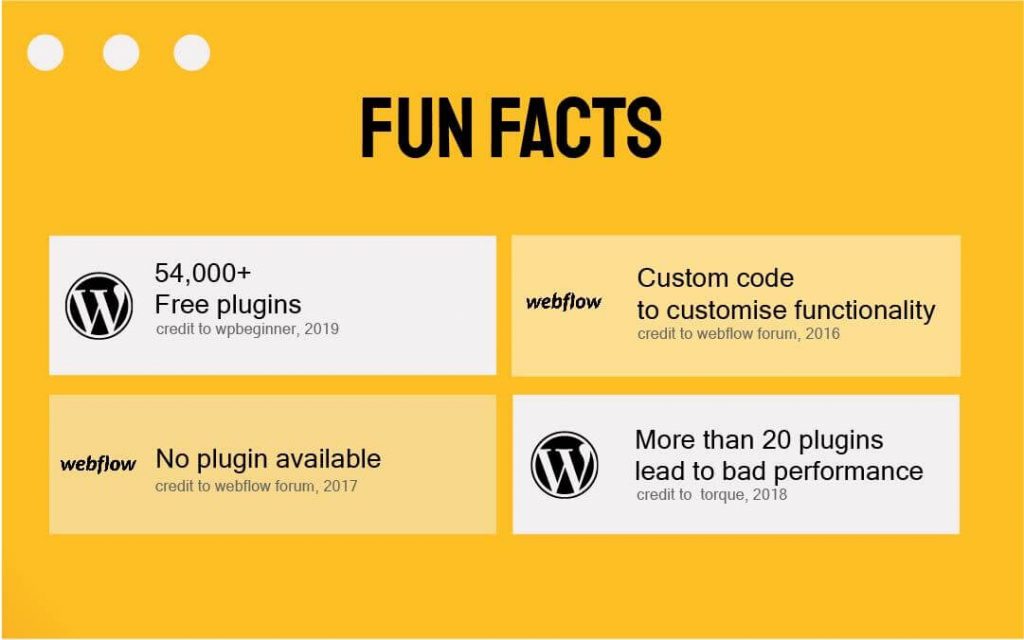Selecting a suitable content management system for your business or website can be a daunting task. There are a host of factors to consider before investing in the ideal platform to design, build, launch and maintain your site.
Has been the reliable choice for many years. Established in 2003, it’s widely known as the most popular website-building platform in the world, and its suite of extensive features and plug-ins are familiar to most designers and developers.
However, the emergence of Webflow in 2013 has offered a fresh and trendy alternative in the experience of website construction. Webflow supports a range of complex functions on more lightweight software, and has been steadily increasing in popularity.
Is it worth making the shift from WordPress to Webflow? Which CMS platform is simply better? Let’s compare several features for both applications in order to help make that decision a little easier.
| WordPress | Webflow | |
|---|---|---|
| Subscription prices (starting from) | 7 USD | 12 USD |
| Customisation | Rely on plugins | Custom coding required |
| Support | Live chat/Community based | Live chat/Community based |
| E-commerce functionality | Yes, with plugins | Yes, different web plans |
| SEO | Plugin available, Schema markup, Meta Tag Editing and more… | Tools built-in internally, Schema Markup, Alt Tag Editing and more.. |
| Design | Drag and drop HTML element | Drag and drop HTML element |
| Ease of use | Yes, with the help of plugins. Majority of WordPress users don’t have coding knowledge | Yes, for advanced customisation may need the help of a web developer |
Pricing

Price is a key factor in determining the right CMS platform for you. You’ll want to ensure that rates stay affordable, especially if you are a start-up or small business.
WordPress is free and open-source software. However, there are costs associated with the purchases of hosting, domain names and any additional plug-ins you may choose to install. Hosting costs vary by platform, but an estimated USD$7 is required for the basic monthly maintenance of your site.
Webflow has various price tiers, with business plans ranging up to USD$36. As a rule, higher package plans will come with more advanced features. Nevertheless, all Webflow site plans will provide you with a basic set of functions including a custom domain, password protection and backup capabilities.
Themes, Templates and Plug-ins

While both platforms offer an extensive collection of themes and templates for your site, there are some differences that may influence your ultimate choice.
WordPress themes are organized by industry and keywords so that you can build your site on a foundation that’s already optimised for your business type. Themes are customisable but only to a certain extent, and the basic structure of your page will remain largely static.
In contrast, Webflow templates are highly customisable and extremely flexible. You have the freedom to adjust and play around with nearly any element of your site without being restricted by the original structure of your selected template.
When it comes to plug-ins, WordPress boasts a massive collection for you to explore. Its open-source foundation and nearly 20 years of operation mean that everyone has the freedom to create and upload plug-ins and apps to the platform. You’ll find a WordPress plug-in for virtually any function you can think of.
On the other hand, Webflow restricts plug-ins from its user base. It runs a third-party integration with Zapier, which provides access to relevant apps you might need. Zapier also ensures that coding on your site remains streamlined and clean. This is in contrast to WordPress, where multiple plug-ins can crowd your page and possibly slow it down.
Technical Support

More than 40% of websites on the Internet are built on WordPress. This coupled with its longevity and open-source operation has resulted in a vast supply of community-based forums and blogs. These resources are dedicated to solving issues and sharing tutorials on making the most of WordPress.
Webflow does offer a dedicated support team for any questions or problems faced by users In general, the platform’s relatively recent history means that you may find yourself having to navigate the system independently.
SEO Friendliness and E-Commerce

Both Webflow and WordPress are evenly matched in terms of SEO optimisation. Webflow in particular has SEO functions built into its existing features, meaning that you won’t need external plug-ins to support or complement your business needs in this area.
WordPress is SEO optimised to a considerable extent, but you’ll need to apply certain plug-ins to boost traffic and search engine results. Some recommended plug-ins for this purpose include Yoast and SEO Service by Web10. Combined with WordPress’ existing SEO functions, your website is likely to perform just as well as a Webflow-based enterprise.
Small businesses that plan to sell items online can take advantage of WordPress’ various e-commerce plug-ins. The most popular is WooCommerce, which hosts 28% of all existing online stores. The majority of e-commerce plug-ins available on WordPress allow you the freedom to tailor themes and features to your preference.
Webflow provides a selection of e-commerce plans at varying price tiers, but all packages include customisable shops, support for multiple payment gateways and integrated marketing features with Instagram, MailChimp and Google Analytics among others.
Design and Ease of Use

User-friendliness is a vital feature to consider in choosing a CMS platform. The average business owner is likely not an expert developer or designer, so it’s ideal to work with an application that keeps things simple.
Webflow is known for its drag-and-drop interface so you can design your site conveniently. It also features a live preview of your site’s appearance on desktop and mobile. Most importantly, Webflow allows for high customisation without requiring in-depth knowledge of coding from its users. However, the sheer scope of available features and functions may call for a somewhat steep learning curve.
WordPress also offers a good level of customisation, but it’s relatively limited in comparison to Webflow. This means you’ll have fewer options to explore and may need assistance from developers if you’d like to experiment with more advanced elements. However, the WordPress Block Editor interface makes basic website building a breeze even for novice users.
Armed with this information, you can now go forth and invest in the best content management system for your particular needs. WordPress provides a much wider range of customisation and control over costs, while Webflow is ideal for those looking into creating professional-looking sites without much coding experience and a higher budget.
Looking to craft an attractive and optimised website for your business needs? Learn more about what we can offer you.







